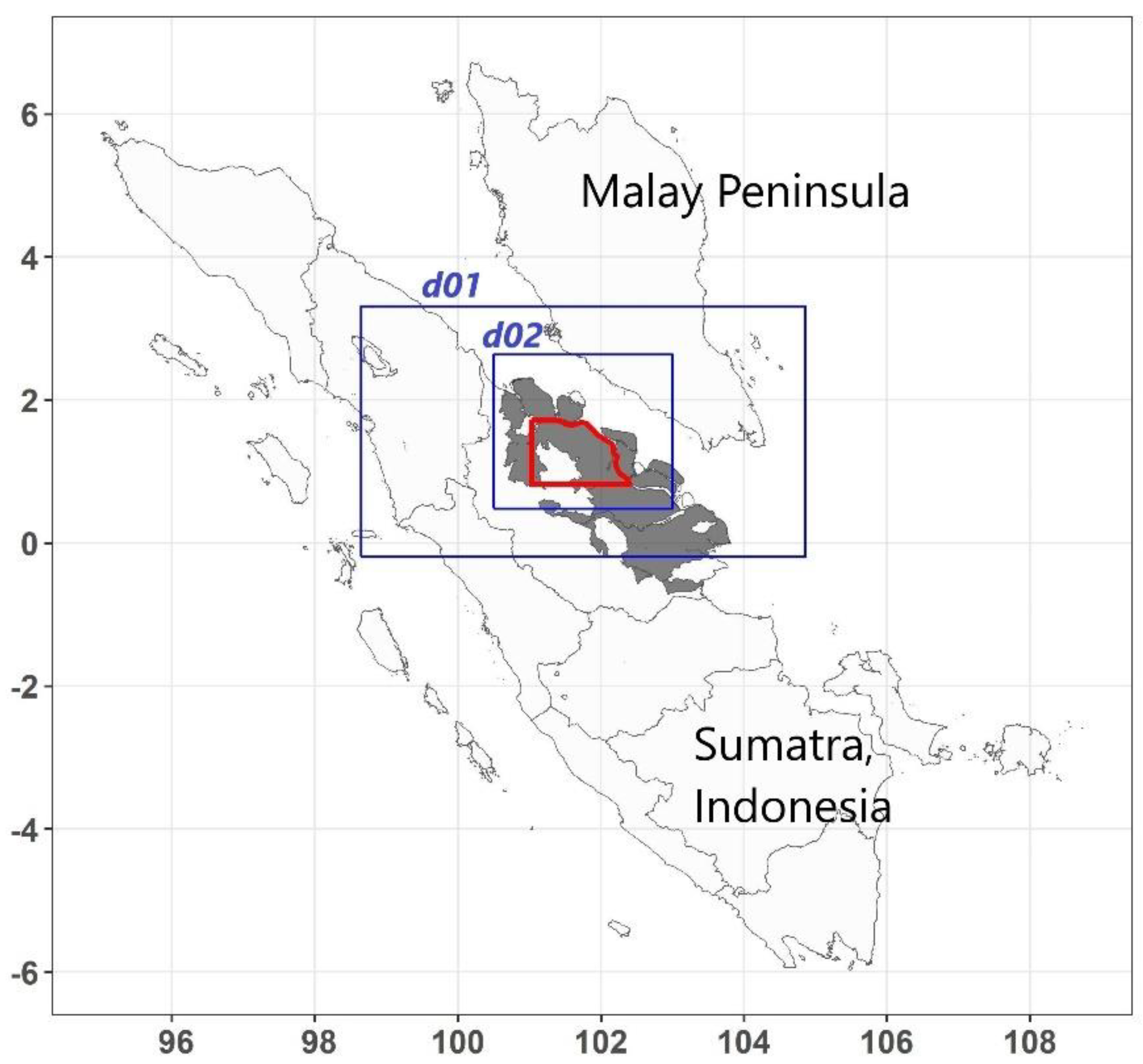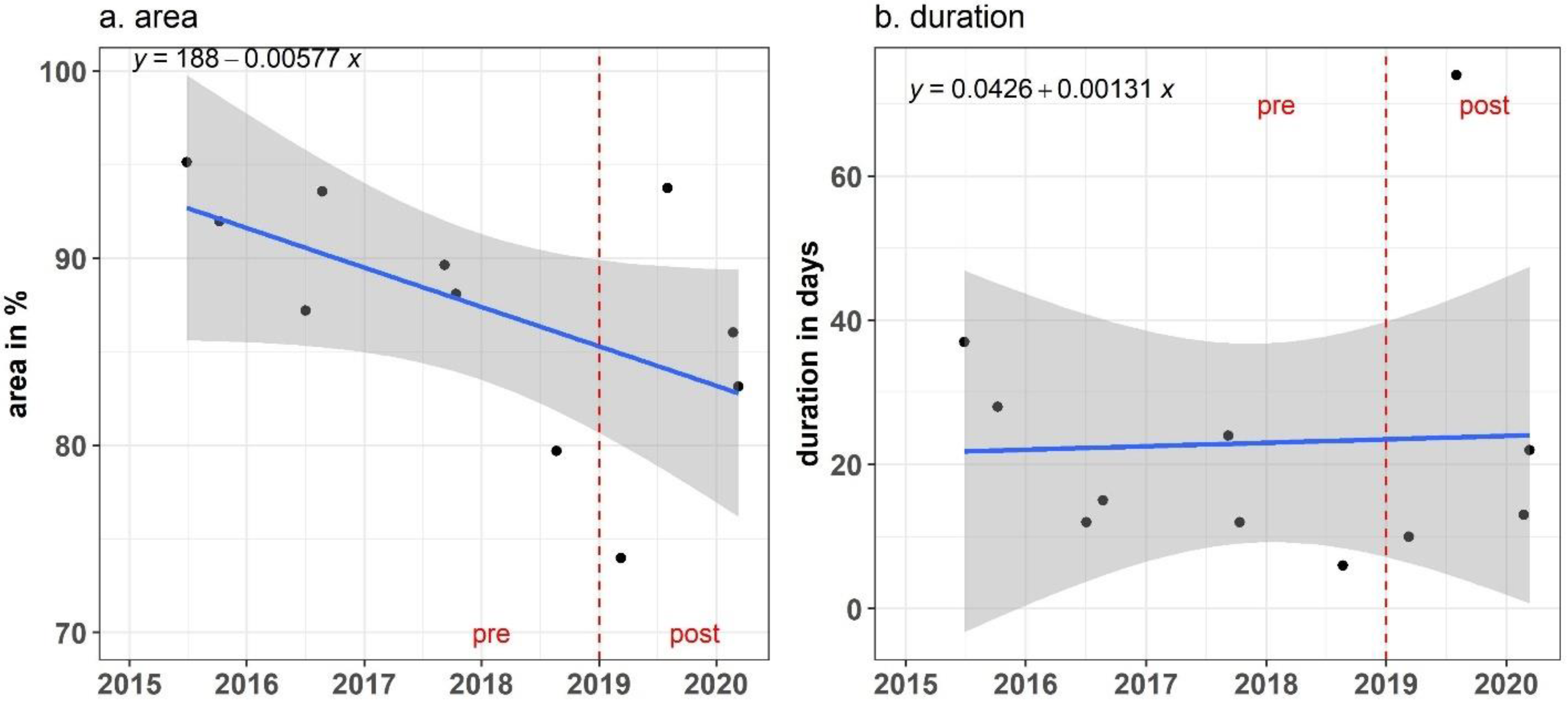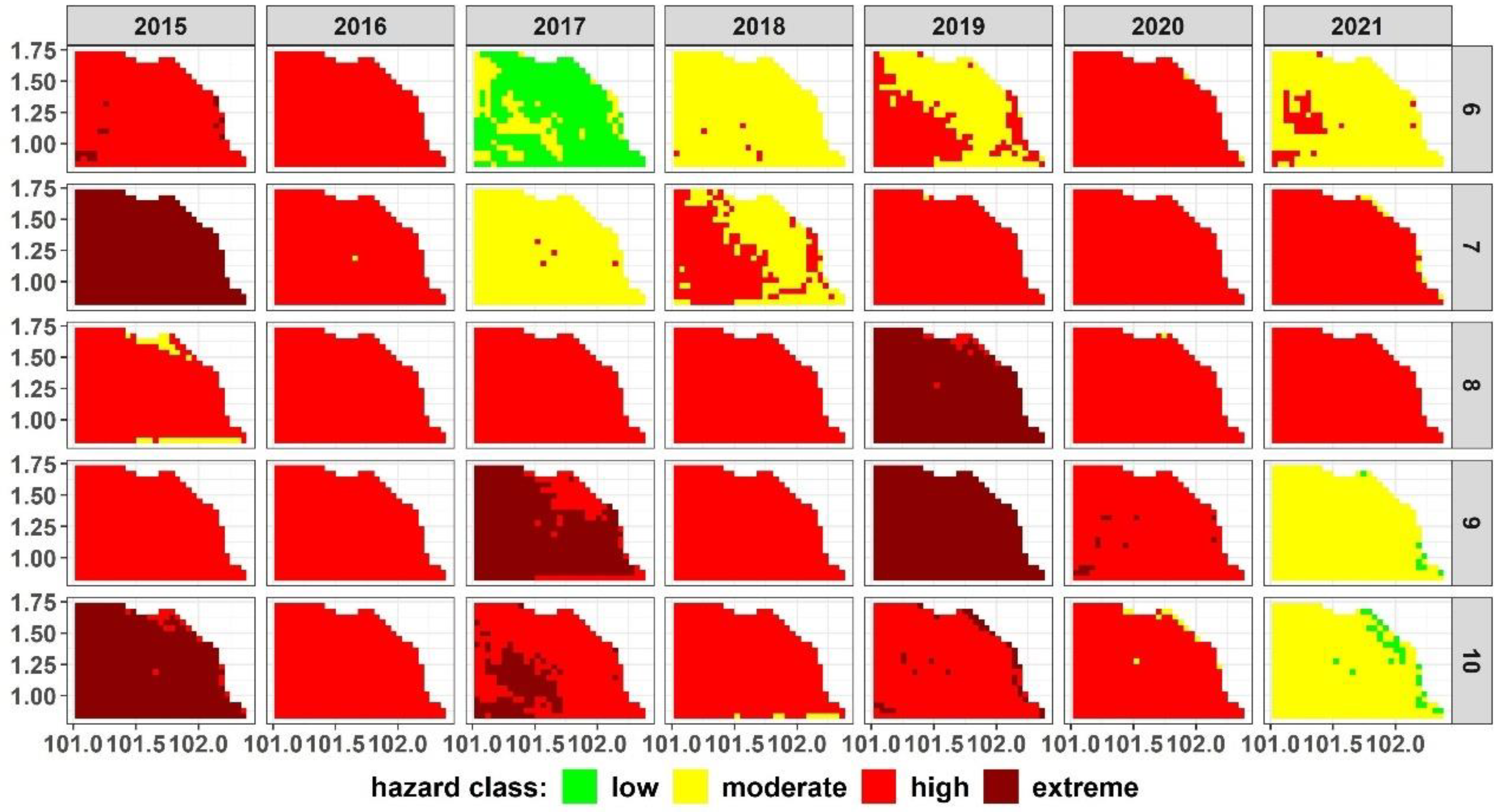The Impact of Rewetting Peatland on Fire Hazard in Riau, Indonesia
Abstract
:1. Introduction
2. Materials and Methods
2.1. Study Area
2.2. Model Setup and Input
2.3. Fire Hazard Assessment
2.4. Assessment on the Rewetting Impcat
2.5. Fire Hotspots
3. Results
3.1. Rainfall Condition for the Study Site
3.2. Characteristics of Extreme Hazard
3.3. Verification of Fire Hazard
4. Discussion
4.1. Spatiotemporal Variation
4.2. Limitations
5. Conclusions
Author Contributions
Funding
Institutional Review Board Statement
Informed Consent Statement
Data Availability Statement
Acknowledgments
Conflicts of Interest
References
- Miettinen, J.; Shi, C.; Liew, S.C. Land Cover Distribution in the Peatlands of Peninsular Malaysia, Sumatra and Borneo in 2015 with Changes since 1990. Glob. Ecol. Conserv. 2016, 6, 67–78. [Google Scholar] [CrossRef] [Green Version]
- Liu, H.; Lennartz, B. Hydraulic Properties of Peat Soils along a Bulk Density Gradient—A Meta Study. Hydrol. Process. 2019, 33, 101–114. [Google Scholar] [CrossRef] [Green Version]
- Silins, U.; Rothwell, R.L. Forest Peatland Drainage and Subsidence Affect Soil Water Retention and Transport Properties in an Alberta Peatland. Soil Sci. Soc. Am. J. 1998, 62, 1048–1056. [Google Scholar] [CrossRef]
- Luscombe, D.J.; Anderson, K.; Grand-Clement, E.; Gatis, N.; Ashe, J.; Benaud, P.; Smith, D.; Brazier, R.E. How Does Drainage Alter the Hydrology of Shallow Degraded Peatlands across Multiple Spatial Scales? J. Hydrol. 2016, 541, 1329–1339. [Google Scholar] [CrossRef] [Green Version]
- Vetrita, Y.; Cochrane, M.A. Fire Frequency and Related Land-Use and Land-Cover Changes in Indonesia’s Peatlands. Remote Sens. 2019, 12, 5. [Google Scholar] [CrossRef] [Green Version]
- Kiely, L.; Spracklen, D.V.; Arnold, S.R.; Papargyropoulou, E.; Conibear, L.; Wiedinmyer, C.; Knote, C.; Adrianto, H.A. Assessing Costs of Indonesian Fires and the Benefits of Restoring Peatland. Nat Commun 2021, 12, 7044. [Google Scholar] [CrossRef]
- Hu, Y.; Christensen, E.G.; Amin, H.M.; Smith, T.E.; Rein, G. Experimental Study of Moisture Content Effects on the Transient Gas and Particle Emissions from Peat Fires. Combust. Flame 2019, 209, 408–417. [Google Scholar] [CrossRef]
- Manning, F.C.; Kho, L.K.; Hill, T.C.; Cornulier, T.; Teh, Y.A. Carbon Emissions From Oil Palm Plantations on Peat Soil. Front. For. Glob. Chang. 2019, 2, 37. [Google Scholar] [CrossRef] [Green Version]
- Prananto, J.A.; Minasny, B.; Comeau, L.-P.; Rudiyanto, R.; Grace, P. Drainage Increases CO2 and N2O Emissions from Tropical Peat Soils. Glob. Chang. Biol. 2020, 26, 4583–4600. [Google Scholar] [CrossRef]
- Taufik, M.; Veldhuizen, A.A.; Wösten, J.H.M.; van Lanen, H.A.J. Exploration of the Importance of Physical Properties of Indonesian Peatlands to Assess Critical Groundwater Table Depths, Associated Drought and Fire Hazard. Geoderma 2019, 347, 160–169. [Google Scholar] [CrossRef]
- Evans, C.D.; Peacock, M.; Baird, A.J.; Artz, R.R.E.; Burden, A.; Callaghan, N.; Chapman, P.J.; Cooper, H.M.; Coyle, M.; Craig, E.; et al. Overriding Water Table Control on Managed Peatland Greenhouse Gas Emissions. Nature 2021, 593, 548–552. [Google Scholar] [CrossRef] [PubMed]
- Konecny, K.; Ballhorn, U.; Navratil, P.; Jubanski, J.; Page, S.E.; Tansey, K.; Hooijer, A.; Vernimmen, R.; Siegert, F. Variable Carbon Losses from Recurrent Fires in Drained Tropical Peatlands. Glob. Chang. Biol 2016, 22, 1469–1480. [Google Scholar] [CrossRef] [PubMed] [Green Version]
- Taufik, M.; Setiawan, B.I.; Van Lanen, H.A.J. Increased Fire Hazard in Human-Modified Wetlands in Southeast Asia. AMBIO 2019, 48, 363–373. [Google Scholar] [CrossRef] [PubMed]
- Ritzema, H.; Limin, S.; Kusin, K.; Jauhiainen, J.; Wösten, H. Canal Blocking Strategies for Hydrological Restoration of Degraded Tropical Peatlands in Central Kalimantan, Indonesia. Catena 2014, 114, 11–20. [Google Scholar] [CrossRef] [Green Version]
- Jaenicke, J.; Englhart, S.; Siegert, F. Monitoring the Effect of Restoration Measures in Indonesian Peatlands by Radar Satellite Imagery. J. Environ. Manag. 2011, 92, 630–638. [Google Scholar] [CrossRef] [PubMed]
- Menberu, M.W.; Tahvanainen, T.; Marttila, H.; Irannezhad, M.; Ronkanen, A.-K.; Penttinen, J.; Kløve, B. Water-Table-Dependent Hydrological Changes Following Peatland Forestry Drainage and Restoration: Analysis of Restoration Success. Water Resour. Res. 2016, 52, 3742–3760. [Google Scholar] [CrossRef] [Green Version]
- Lestari, I.; Murdiyarso, D.; Taufik, M. Rewetting Tropical Peatlands Reduced Net Greenhouse Gas Emissions in Riau Province, Indonesia. Forests 2022, 13, 505. [Google Scholar] [CrossRef]
- Murdiyarso, D.; Lestari, I.; Hanggara, B.B.; Saragi-Sasmito, M.; Basuki, I.; Taufik, M. Managing Water Regimes: Controlling Greenhouse Gas Emissions and Fires in Indonesian Tropical Peat Swamp Forests. In Geophysical Monograph Series; Krauss, K.W., Zhu, Z., Stagg, C.L., Eds.; Wiley: New York, NY, USA, 2021; pp. 355–369. ISBN 978-1-119-63928-2. [Google Scholar]
- Powers, J.G.; Klemp, J.B.; Skamarock, W.C.; Davis, C.A.; Dudhia, J.; Gill, D.O.; Coen, J.L.; Gochis, D.J.; Ahmadov, R.; Peckham, S.E.; et al. The Weather Research and Forecasting Model: Overview, System Efforts, and Future Directions. Bull. Am. Meteorol. Soc. 2017, 98, 1717–1737. [Google Scholar] [CrossRef]
- Clarke, H.; Evans, J.P.; Pitman, A.J. Fire Weather Simulation Skill by the Weather Research and Forecasting (WRF) Model over South-East Australia from 1985 to 2009. Int. J. Wildland Fire 2013, 22, 739. [Google Scholar] [CrossRef]
- Mandal, A.; Nykiel, G.; Strzyzewski, T.; Kochanski, A.; Wrońska, W.; Gruszczynska, M.; Figurski, M.; Mandal, A.; Nykiel, G.; Strzyzewski, T.; et al. High-Resolution Fire Danger Forecast for Poland Based on the Weather Research and Forecasting Model. Int. J. Wildland Fire 2021, 31, 149–162. [Google Scholar] [CrossRef]
- Mölders, N. Suitability of the Weather Research and Forecasting (WRF) Model to Predict the June 2005 Fire Weather for Interior Alaska. Weather Forecast. 2008, 23, 953–973. [Google Scholar] [CrossRef]
- Sanusi, A.R.; Taufik, M.; Santikayasa, I.P. The Use of Weather Research and Forecasting Model to Predict Rainfall in Tropical Peatland: 1. Model Parameterization. J.Agromet 2021, 35, 49–59. [Google Scholar] [CrossRef]
- Lisnawati; Taufik, M.; Dasanto, B.D.; Sopaheluwakan, A. Fire Danger on Jambi Peatland Indonesia Based on Weather Research and Forecasting Model. Agromet 2022, 36, 1–10. [Google Scholar] [CrossRef]
- Anda, M.; Ritung, S.; Suryani, E.; Sukarman; Hikmat, M.; Yatno, E.; Mulyani, A.; Subandiono, R.E.; Suratman; Husnain. Revisiting Tropical Peatlands in Indonesia: Semi-Detailed Mapping, Extent and Depth Distribution Assessment. Geoderma 2021, 402, 115235. [Google Scholar] [CrossRef]
- Li, H.; Wolter, M.; Wang, X.; Sodoudi, S. Impact of Land Cover Data on the Simulation of Urban Heat Island for Berlin Using WRF Coupled with Bulk Approach of Noah-LSM. Theor. Appl. Climatol. 2018, 134, 67–81. [Google Scholar] [CrossRef]
- Mandel, J.; Amram, S.; Beezley, J.D.; Kelman, G.; Kochanski, A.K.; Kondratenko, V.Y.; Lynn, B.H.; Regev, B.; Vejmelka, M. Recent Advances and Applications of WRF–SFIRE. Nat. Hazards Earth Syst. Sci. 2014, 14, 2829–2845. [Google Scholar] [CrossRef] [Green Version]
- Ratna, S.B.; Ratnam, J.V.; Behera, S.K.; Tangang, F.T.; Yamagata, T. Validation of the WRF Regional Climate Model over the Subregions of Southeast Asia: Climatology and Interannual Variability. Clim. Res. 2017, 71, 263–280. [Google Scholar] [CrossRef] [Green Version]
- Wang, N.; Guo, H.; Jiang, F.; Ling, Z.H.; Wang, T. Simulation of Ozone Formation at Different Elevations in Mountainous Area of Hong Kong Using WRF-CMAQ Model. Sci. Total Environ. 2015, 505, 939–951. [Google Scholar] [CrossRef]
- Rogers, E.; Black, T.; Ferrier, B.; Lin, Y.; Parrish, D.; DiMego, G. Changes to the NCEP Meso Eta Analysis and Forecast System: Increase in Resolution, New Cloud Microphysics, Modified Precipitation Assimilation, Modified 3DVAR Analysis; NWS Technical Procedures Bulletin; NASA: Washington, DC, USA, 2001. [Google Scholar]
- Chou, M.D.; Suarez, M.J. A Solar Radiation Parameterization (CLIRAD-SW) Developed at Goddard Climate and Radiation Branch for Atmospheric Studies; NASA Technical Memorandum NASA/TM-1999-104606; NASA: Washington, DC, USA, 1999. [Google Scholar]
- Mlawer, E.J.; Taubman, S.J.; Brown, P.D.; Iacono, M.J.; Clough, S.A. Radiative Transfer for Inhomogeneous Atmospheres: RRTM, a Validated Correlated-k Model for the Longwave. J. Geophys. Res. Atmos. 1997, 102, 16663–16682. [Google Scholar] [CrossRef] [Green Version]
- Janjić, Z.I. The Mellor-Yamada Level 2.5 Scheme in the NCEP Eta Model. In Proceedings of the Eleventh Conference on Numerical Weather Prediction, Norfolk, VA, USA, 19–23 August 1996; Amer. Meteor. Soc.: Boston, MA, USA, 1996; pp. 354–355. [Google Scholar]
- Tewari, M.; Chen, F.; Wang, W.; Dudhia, J.; LeMone, M.A.; Mitchell, K.; Ek, M.; Gayno, G.; Wegiel, J.; Cuenca, R.H. Implementation and Verification of the Unified Noah Land Surface Model in the WRF Model. Bull. Am. Meteorol. Soc. 2004, 14, 2165–2170. [Google Scholar]
- Janjić, Z.I. The Step-Mountain Eta Coordinate Model: Further Developments of the Convection, Viscous Sublayer, and Turbulence Closure Schemes. Mon. Weather Rev. 1994, 122, 927–945. [Google Scholar] [CrossRef]
- Grell, G.A.; Dévényi, D. A Generalized Approach to Parameterizing Convection Combining Ensemble and Data Assimilation Techniques. Geophys. Res. Lett. 2002, 29, 10–13. [Google Scholar] [CrossRef] [Green Version]
- Taufik, M.; Widyastuti, M.T.; Sulaiman, A.; Murdiyarso, D.; Santikayasa, I.P.; Minasny, B. An Improved Drought-Fire Assessment for Managing Fire Risks in Tropical Peatlands. Agric. For. Meteorol. 2022, 312, 108738. [Google Scholar] [CrossRef]
- R Core Team. R: A Language and Environment for Statistical Computing 2022. Available online: https://www.R-project.org/ (accessed on 2 December 2022).
- Wickham, H.; Averick, M.; Bryan, J.; Chang, W.; McGowan, L.; François, R.; Grolemund, G.; Hayes, A.; Henry, L.; Hester, J.; et al. Welcome to the Tidyverse. JOSS 2019, 4, 1686. [Google Scholar] [CrossRef] [Green Version]
- Hijmans, R. Raster: Geographic Data Analysis and Modeling. R Package Version 3.6-3. 2022. Available online: https://CRAN.R-Project.Org/Package=raster (accessed on 2 December 2022).
- Hayasaka, H.; Usup, A.; Naito, D. New Approach Evaluating Peatland Fires in Indonesian Factors. Remote Sens. 2020, 12, 2055. [Google Scholar] [CrossRef]
- Miettinen, J.; Shi, C.; Liew, S.C. Fire Distribution in Peninsular Malaysia, Sumatra and Borneo in 2015 with Special Emphasis on Peatland Fires. Environ. Manag. 2017, 60, 747–757. [Google Scholar] [CrossRef]
- Field, R.D.; van der Werf, G.R.; Shen, S.S.P. Human Amplification of Drought-Induced Biomass Burning in Indonesia since 1960. Nat. Geosci 2009, 2, 185–188. [Google Scholar] [CrossRef]
- Horton, A.J.; Lehtinen, J.; Kummu, M. Targeted Land Management Strategies Could Halve Peatland Fire Occurrences in Central Kalimantan, Indonesia. Commun Earth Env. 2022, 3, 204. [Google Scholar] [CrossRef]
- Taufik, M.; Torfs, P.J.J.F.; Uijlenhoet, R.; Jones, P.D.; Murdiyarso, D.; Van Lanen, H.A.J. Amplification of Wildfire Area Burnt by Hydrological Drought in the Humid Tropics. Nat. Clim. Chang. 2017, 7, 428–431. [Google Scholar] [CrossRef] [Green Version]
- Kurniadi, A.; Weller, E.; Min, S.-K.; Seong, M.-G. Independent ENSO and IOD Impacts on Rainfall Extremes over Indonesia. Int. J. Climatol. 2021, 41, 3640–3656. [Google Scholar] [CrossRef]
- Nurdiati, S.; Sopaheluwakan, A.; Septiawan, P. Joint Pattern Analysis of Forest Fire and Drought Indicators in Southeast Asia Associated with ENSO and IOD. Atmosphere 2022, 13, 1198. [Google Scholar] [CrossRef]
- Pan, X.; Chin, M.; Ichoku, C.M.; Field, R.D. Connecting Indonesian Fires and Drought With the Type of El Niño and Phase of the Indian Ocean Dipole During 1979–2016. J. Geophys. Res. Atmos. 2018, 123, 7974–7988. [Google Scholar] [CrossRef]
- Amirudin, A.A.; Salimun, E.; Tangang, F.; Juneng, L.; Zuhairi, M. Differential Influences of Teleconnections from the Indian and Pacific Oceans on Rainfall Variability in Southeast Asia. Atmosphere 2020, 11, 886. [Google Scholar] [CrossRef]
- Durner, W.; Lipsius, K. Determining Soil Hydraulic Properties. In Encyclopedia of Hydrological Sciences; John Wiley & Sons: Hoboken, NJ, USA, 2006; pp. 1–23. [Google Scholar]
- Weber, T.K.D.; Durner, W.; Streck, T.; Diamantopoulos, E. A Modular Framework for Modeling Unsaturated Soil Hydraulic Properties Over the Full Moisture Range. Water Resour. Res. 2019, 55, 4994–5011. [Google Scholar] [CrossRef]
- Kurnianto, S.; Selker, J.; Boone Kauffman, J.; Murdiyarso, D.; Peterson, J.T. The Influence of Land-Cover Changes on the Variability of Saturated Hydraulic Conductivity in Tropical Peatlands. Mitig. Adapt. Strat. Glob. Chang. 2019, 24, 535–555. [Google Scholar] [CrossRef]
- Henderson, D.S.; Kummerow, C.D.; Berg, W. ENSO Influence on TRMM Tropical Oceanic Precipitation Characteristics and Rain Rates. J. Clim. 2018, 31, 3979–3998. [Google Scholar] [CrossRef]
- Nwachukwu, P.N.; Satge, F.; Yacoubi, S.E.; Pinel, S.; Bonnet, M.-P. From TRMM to GPM: How Reliable Are Satellite-Based Precipitation Data across Nigeria? Remote Sens. 2020, 12, 3964. [Google Scholar] [CrossRef]
- Iskandar, I.; Lestari, D.O.; Masumoto, Y. La Niña Modoki Enhanced Summer-Autumn Precipitation over the Indonesian Region. Asia-Pac J Atmos Sci 2022, 58, 507–517. [Google Scholar] [CrossRef]
- Rodysill, J.R.; Russell, J.M.; Vuille, M.; Dee, S.; Lunghino, B.; Bijaksana, S. La Niña-Driven Flooding in the Indo-Pacific Warm Pool during the Past Millennium. Quat. Sci. Rev. 2019, 225, 106020. [Google Scholar] [CrossRef]





| Item | Domain 1 | Domain 2 |
|---|---|---|
| Grid spacing | 15 km | 5 km |
| Microphysics | Eta Scheme [30] | |
| Short-wave radiation | New Goddard Scheme [31] | |
| Long-wave radiation | RRTM Scheme [32] | |
| Surface layer | Monin–Obukhov (Janjic Eta) Scheme [33] | |
| Land-surface model | Unified Noah land-surface model [34] | |
| Boundary layer | MYJ Scheme [35] | |
| Cumulus parametrization | Grell–Devenyi Ensemble Scheme [36] | |
| No | Start | End | Duration (Days) | Coverage Area (%) |
|---|---|---|---|---|
| Pre-rewetting | ||||
| 1 | 28 June 2015 | 4 August 2015 | 37 | 95.1 |
| 2 | 8 October 2015 | 5 November 2015 | 28 | 92.0 |
| 3 | 3 July 2016 | 15 July 2016 | 12 | 87.2 |
| 4 | 23 August 2016 | 7 September 2016 | 15 | 93.6 |
| 5 | 8 September 2017 | 2 October 2017 | 24 | 89.6 |
| 6 | 13 October 2017 | 25 October 2017 | 12 | 88.1 |
| 7 | 22 August 2018 | 28 August 2018 | 6 | 79.7 |
| mean | 19.1 | 89.3 | ||
| Post-rewetting | ||||
| 1 | 11 March 2019 | 21 March 2019 | 10 | 74.0 |
| 2 | 3 August 2019 | 16 October 2019 | 74 | 93.8 |
| 3 | 23 February 2020 | 7 March 2020 | 13 | 86.0 |
| 4 | 11 March 2020 | 2 April 2020 | 22 | 83.1 |
| mean | 29.8 | 84.2 | ||
Disclaimer/Publisher’s Note: The statements, opinions and data contained in all publications are solely those of the individual author(s) and contributor(s) and not of MDPI and/or the editor(s). MDPI and/or the editor(s) disclaim responsibility for any injury to people or property resulting from any ideas, methods, instructions or products referred to in the content. |
© 2023 by the authors. Licensee MDPI, Basel, Switzerland. This article is an open access article distributed under the terms and conditions of the Creative Commons Attribution (CC BY) license (https://creativecommons.org/licenses/by/4.0/).
Share and Cite
Taufik, M.; Haikal, M.; Widyastuti, M.T.; Arif, C.; Santikayasa, I.P. The Impact of Rewetting Peatland on Fire Hazard in Riau, Indonesia. Sustainability 2023, 15, 2169. https://doi.org/10.3390/su15032169
Taufik M, Haikal M, Widyastuti MT, Arif C, Santikayasa IP. The Impact of Rewetting Peatland on Fire Hazard in Riau, Indonesia. Sustainability. 2023; 15(3):2169. https://doi.org/10.3390/su15032169
Chicago/Turabian StyleTaufik, Muh, Mudrik Haikal, Marliana Tri Widyastuti, Chusnul Arif, and I. Putu Santikayasa. 2023. "The Impact of Rewetting Peatland on Fire Hazard in Riau, Indonesia" Sustainability 15, no. 3: 2169. https://doi.org/10.3390/su15032169
APA StyleTaufik, M., Haikal, M., Widyastuti, M. T., Arif, C., & Santikayasa, I. P. (2023). The Impact of Rewetting Peatland on Fire Hazard in Riau, Indonesia. Sustainability, 15(3), 2169. https://doi.org/10.3390/su15032169







